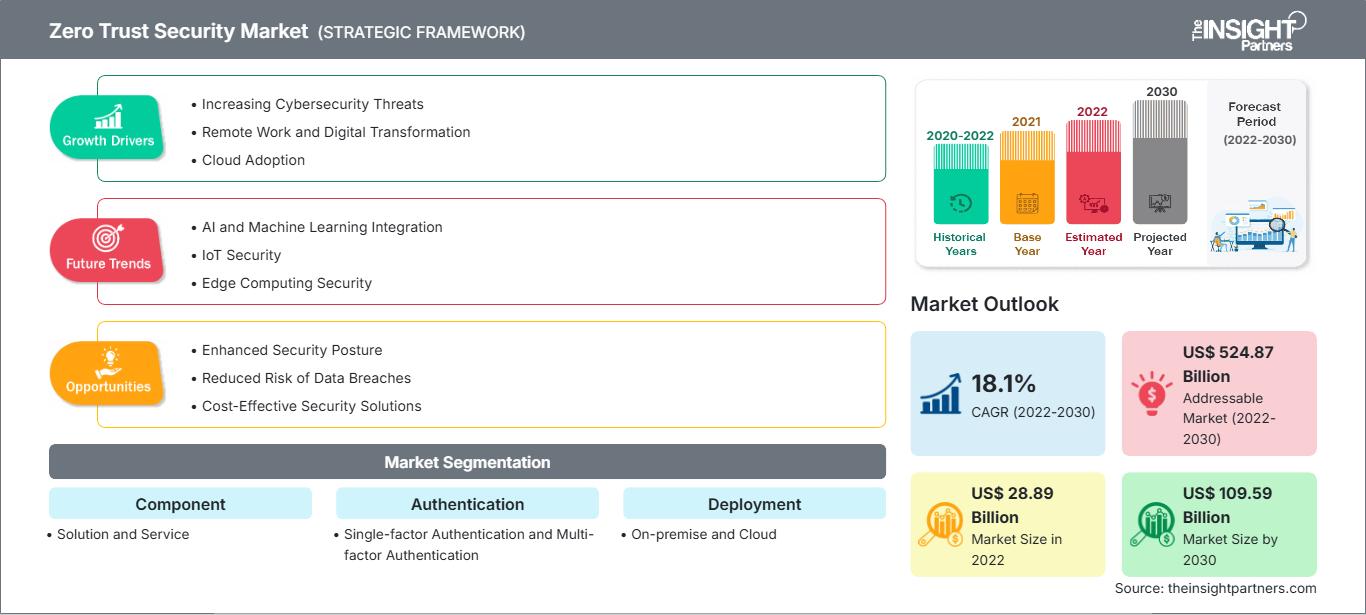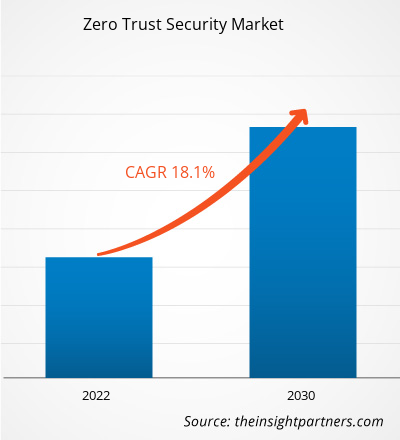[Rapporto di ricerca] Il mercato della sicurezza Zero Trust è stato valutato a 28,89 miliardi di dollari nel 2022 e si prevede che raggiungerà i 109,59 miliardi di dollari entro il 2030; si stima che registrerà un CAGR del 18,1% dal 2022 al 2030.
Prospettiva dell'analista di mercato della sicurezza Zero Trust:
La gestione delle identità e degli accessi (IAM) è un elemento cruciale di un approccio alla sicurezza Zero Trust, poiché aiuta le organizzazioni a garantire che gli utenti non autorizzati non abbiano accesso a risorse sensibili. Implementando sistemi IAM, le aziende possono stabilire e imporre policy per determinare chi ha accesso a quali risorse e possono verificare costantemente l'identità di utenti e dispositivi per salvaguardare la sicurezza e garantire che siano autorizzati ad accedere a risorse specifiche. Inoltre, i sistemi IAM possono aiutare le aziende a monitorare l'accesso degli utenti alle risorse e a rilevare tentativi di accesso non autorizzato o attività illegittime. Ciò può aiutare le organizzazioni a identificare e prevenire probabili violazioni della sicurezza; pertanto, rappresenta una risorsa importante per la conformità ai requisiti normativi relativi alla privacy e alla sicurezza dei dati. Pertanto, con la soluzione IAM appropriata, le aziende possono stabilire metodi di autenticazione e autorizzazione Zero Trust, nonché crittografia Zero Trust per i dati in transito e a riposo.
Panoramica del mercato della sicurezza Zero Trust:
Il mercato globale della sicurezza Zero Trust sta vivendo una forte crescita e si stima che continuerà a espandersi nei prossimi anni. Zero Trust è un framework che garantisce la sicurezza dell'infrastruttura e dei dati di un'azienda. Risponde esclusivamente alle sfide contemporanee del business odierno, tra cui la protezione di ambienti cloud ibridi, lavoratori da remoto e minacce ransomware. Il mercato della sicurezza Zero Trust è moderatamente frammentato. Gli operatori del mercato stanno espandendo il proprio business utilizzando vari metodi, come l'espansione del portafoglio prodotti, l'espansione dei servizi, le fusioni e le acquisizioni. Acquisizioni (M&A) e collaborazioni. Nel giugno 2023, AKITA, fornitore leader di soluzioni tecnologiche Zero Trust e di sicurezza di rete, si è fusa con odixa, un importante fornitore di soluzioni avanzate per la prevenzione del malware. Si prevede che la fusione consentirà alla nuova società di offrire soluzioni di sicurezza informatica Zero Trust avanzate e complete alla propria clientela.
Personalizza questo rapporto in base alle tue esigenze
Potrai personalizzare gratuitamente qualsiasi rapporto, comprese parti di questo rapporto, o analisi a livello di paese, pacchetto dati Excel, oltre a usufruire di grandi offerte e sconti per start-up e università
Mercato della sicurezza Zero Trust: Approfondimenti strategici

- Ottieni le principali tendenze chiave del mercato di questo rapporto.Questo campione GRATUITO includerà l'analisi dei dati, che vanno dalle tendenze di mercato alle stime e alle previsioni.
Potrai personalizzare gratuitamente qualsiasi rapporto, comprese parti di questo rapporto, o analisi a livello di paese, pacchetto dati Excel, oltre a usufruire di grandi offerte e sconti per start-up e università
Mercato della sicurezza Zero Trust: Approfondimenti strategici

- Ottieni le principali tendenze chiave del mercato di questo rapporto.Questo campione GRATUITO includerà l'analisi dei dati, che vanno dalle tendenze di mercato alle stime e alle previsioni.
Driver del mercato della sicurezza Zero Trust:
L'aumento del Bring Your Own Device (BYOD) alimenta la crescita del mercato della sicurezza Zero Trust
Molti noti esperti di dati concordano sul fatto che i dati generati cresceranno esponenzialmente durante il periodo di previsione. Secondo la ricerca del rapporto Data Age 2025 di Seagate, la sfera di dati mondiale raggiungerà i 175 zettabyte entro il 2025. Questo sviluppo è attribuito all'enorme aumento di persone che lavorano, studiano e utilizzano piattaforme di streaming da casa. Pertanto, si prevede che tale cambiamento creerà opportunità redditizie per gli operatori del mercato della sicurezza Zero Trust nel periodo di previsione. Inoltre, si prevede che l'infrastruttura IT diventerà più complessa e diversificata a causa delle normative Bring Your Own Device (BYOD), dell'utilizzo di app aziendali, dell'introduzione di nuove piattaforme, delle tendenze Choose Your Own Device (CYOD) e dell'implementazione di altre tecnologie. Le tendenze BYOD e CYOD stanno diventando sempre più diffuse in ambito aziendale grazie ai rapidi progressi nel mobile computing. Pertanto, i dipendenti possono accedere ai dati aziendali tramite dispositivi mobili in qualsiasi momento, aumentandone la produttività. L'installazione di soluzioni Zero Trust, in questi casi, garantisce la sicurezza e la riservatezza dei dati aziendali. Questi fattori stanno alimentando fortemente la domanda di soluzioni e servizi offerti dagli operatori del mercato della sicurezza Zero Trust.
Analisi segmentale del mercato della sicurezza Zero Trust:
Il mercato della sicurezza Zero Trust è classificato in base a componente, autenticazione, implementazione, dimensioni dell'organizzazione, applicazione e utilizzo finale. In base al componente, il mercato della sicurezza Zero Trust si suddivide in soluzione e servizio. In termini di autenticazione, il mercato si suddivide in autenticazione a fattore singolo e autenticazione a più fattori. In base all'implementazione, il mercato si suddivide in on-premise e cloud. In base alle dimensioni dell'organizzazione, il mercato si suddivide in PMI e grandi imprese. In termini di applicazione, il mercato si suddivide in endpoint, rete e altri. In base all'utilizzo finale, il mercato è segmentato in BFSI, e-commerce e vendita al dettaglio, sanità, IT e telecomunicazioni e altri. In base all'area geografica, il mercato della sicurezza Zero Trust è segmentato in Nord America, Europa, Asia-Pacifico (APAC), Medio Oriente e Africa (MEA) e Sud America (SAM).
L'autenticazione a fattore singolo semplifica l'autenticazione Zero Trust consentendo agli utenti di accedere a più risorse e sistemi con un unico set di credenziali, anziché richiedere informazioni di accesso diverse per ogni sistema. Può migliorare l'esperienza utente e ridurre il rischio che gli utenti scelgano password deboli, nonché il rischio che gli utenti riutilizzino le password su più sistemi. L'autenticazione a più fattori potrebbe sembrare macchinosa per l'utente, ma è considerata più sicura. Imponendo più fattori di autenticazione, aiuta le organizzazioni a garantire che solo gli utenti approvati possano accedere a risorse sensibili, rendendo più difficile per gli aggressori ottenere l'accesso illecito, anche se riescono a ottenere la password di un utente. Viene spesso utilizzato in combinazione con altre soluzioni Zero Trust, come i sistemi IAM, per fornire un ulteriore livello di sicurezza.
Analisi regionale del mercato della sicurezza Zero Trust:
Lo sviluppo delle leggi sulla protezione dei dati e sulla sicurezza informatica nei paesi asiatici si sta espandendo in modo significativo. Con l'ingresso degli individui nella nuova realtà digitale tramite dispositivi mobili e Internet delle cose (IoT), si registra un aumento delle iniziative governative volte a promuovere programmi di identità digitale e approcci invasivi alla sorveglianza elettronica. A questo proposito, l'applicazione del Regolamento generale sulla protezione dei dati (GDPR) e delle norme sulla protezione dei dati nella regione sta guadagnando attenzione. Ad esempio, la regione ha registrato progressi significativi in Cina. Si presume che l'APAC emergerà come la regione in più rapida crescita nel periodo di previsione. La crescente accettazione dei dispositivi mobili nelle aziende e delle applicazioni IoT è la principale responsabile della crescita del mercato nella regione. Inoltre, la crescente adozione di policy BYOD (Bring Your Own Device) e di soluzioni basate su cloud è un altro fattore che contribuisce alla crescita del mercato della sicurezza Zero Trust. Inoltre, si prevede che la crescita delle tendenze nei luoghi di lavoro digitali e la trasformazione nei data center stimoleranno la crescita del mercato della sicurezza Zero Trust nel periodo di previsione.
Mercato della sicurezza Zero Trust
Le tendenze e i fattori regionali che hanno influenzato il mercato della sicurezza Zero Trust durante il periodo di previsione sono stati ampiamente spiegati dagli analisti di The Insight Partners. Questa sezione illustra anche i segmenti e la distribuzione geografica del mercato della sicurezza Zero Trust in Nord America, Europa, Asia-Pacifico, Medio Oriente e Africa, America Meridionale e Centrale.
Ambito del rapporto sul mercato della sicurezza Zero Trust
| Attributo del rapporto | Dettagli |
|---|---|
| Dimensioni del mercato in 2022 | US$ 28.89 Billion |
| Dimensioni del mercato per 2030 | US$ 109.59 Billion |
| CAGR globale (2022 - 2030) | 18.1% |
| Dati storici | 2020-2022 |
| Periodo di previsione | 2022-2030 |
| Segmenti coperti |
By Componente
|
| Regioni e paesi coperti | Nord America
|
| Leader di mercato e profili aziendali chiave |
|
Densità degli operatori del mercato della sicurezza Zero Trust: comprendere il suo impatto sulle dinamiche aziendali
Il mercato della sicurezza Zero Trust è in rapida crescita, trainato dalla crescente domanda degli utenti finali, dovuta a fattori quali l'evoluzione delle preferenze dei consumatori, i progressi tecnologici e una maggiore consapevolezza dei vantaggi del prodotto. Con l'aumento della domanda, le aziende stanno ampliando la propria offerta, innovando per soddisfare le esigenze dei consumatori e sfruttando le tendenze emergenti, alimentando ulteriormente la crescita del mercato.

- Ottieni il Mercato della sicurezza Zero Trust Panoramica dei principali attori chiave
Analisi dei principali attori del mercato della sicurezza Zero Trust:
Akamai Technologies Inc, Cato Networks Ltd, Check Point Software Technologies Ltd, Cisco Systems Inc, Fortinet Inc, Microsoft Corporation, Okta Inc, Palo Alto Networks Inc, VMWare Inc e Zscaler Inc sono tra i principali attori del mercato della sicurezza Zero Trust. Diverse altre importanti aziende sono state analizzate durante questo studio di ricerca per ottenere una visione olistica dell'ecosistema del mercato della sicurezza Zero Trust.
Sviluppi recenti del mercato della sicurezza Zero Trust:
Gli attori del mercato della sicurezza Zero Trust adottano ampiamente strategie inorganiche e organiche. Di seguito sono elencati alcuni importanti sviluppi nel mercato della sicurezza Zero Trust:
- Nell'agosto 2023, Check Point Software, azienda leader nella sicurezza informatica, ha annunciato l'acquisizione di Perimeter 81, fornitore di servizi di accesso sicuro (SASE) e sicurezza di rete, per 490 milioni di dollari, per migliorare la propria offerta di sicurezza oltre il perimetro di rete. La prima azienda prevede di integrare la tecnologia di accesso alla rete Zero Trust e di implementazione rapida della seconda nella sua attuale architettura di prodotto Infinity.
- Nel marzo 2023, Hewlett Packard Enterprise ha annunciato il suo piano di acquisizione della startup informatica israeliana Axis Security. Quest'ultima azienda offre soluzioni Security Services Edge (SSE) basate su cloud che consentono l'accesso alle risorse cloud aziendali e pubbliche.
- Analisi storica (2 anni), anno base, previsione (7 anni) con CAGR
- Analisi PEST e SWOT
- Valore/volume delle dimensioni del mercato - Globale, Regionale, Nazionale
- Industria e panorama competitivo
- Set di dati Excel
Report recenti
Rapporti correlati
Testimonianze
Motivo dell'acquisto
- Processo decisionale informato
- Comprensione delle dinamiche di mercato
- Analisi competitiva
- Analisi dei clienti
- Previsioni di mercato
- Mitigazione del rischio
- Pianificazione strategica
- Giustificazione degli investimenti
- Identificazione dei mercati emergenti
- Miglioramento delle strategie di marketing
- Aumento dell'efficienza operativa
- Allineamento alle tendenze normative




















 Ottieni un campione gratuito per - Mercato della sicurezza Zero Trust
Ottieni un campione gratuito per - Mercato della sicurezza Zero Trust